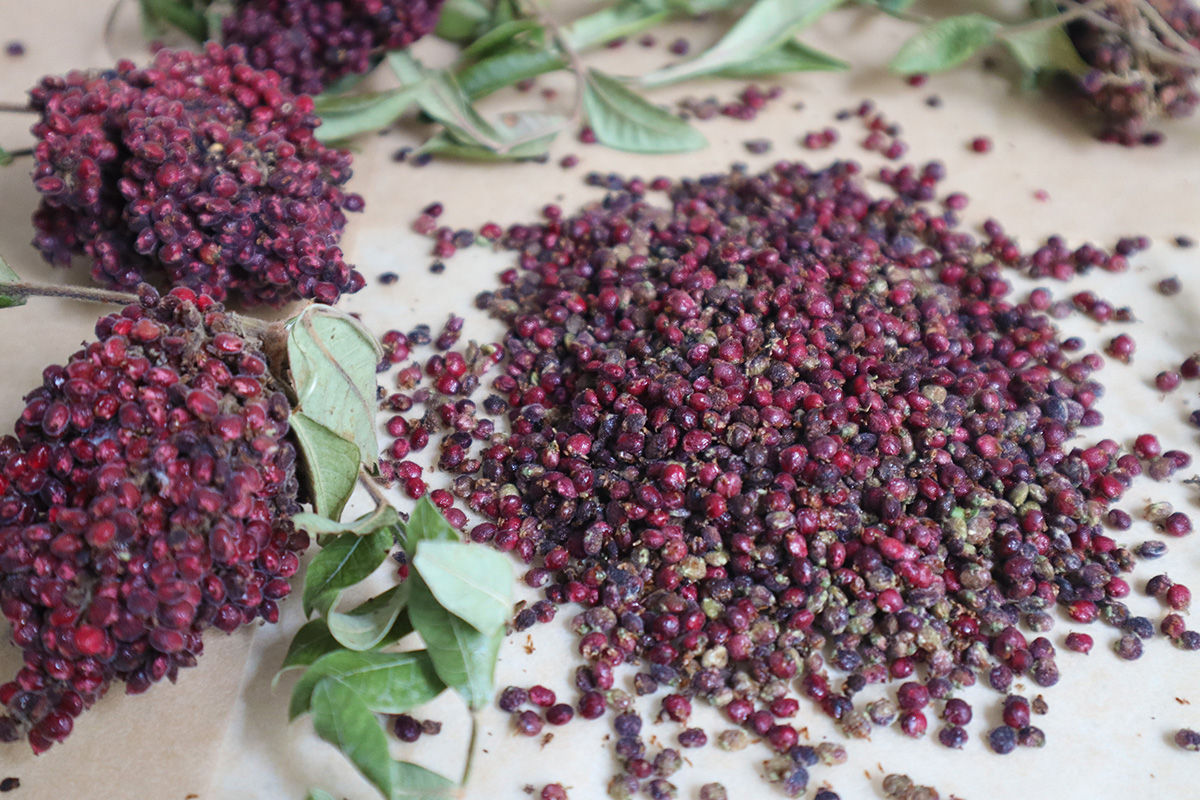

Photography by Marie Viljoen.
Photography by Marie Viljoen.
Sumac, the sour red spice, is associated almost exclusively with Mediterranean and Middle Eastern food traditions. Here’s how to identify it, plant it for autumnal beauty, and process its fruit to make the rivetingly sour spice.
Sumac, the sour red spice, is associated almost exclusively with Mediterranean and Middle Eastern food traditions. Here’s how to identify it, plant it for autumnal beauty, and process its fruit to make the rivetingly sour spice.
Narrow green “wings” hug the petiole between leaflets, giving winged sumac a plush appearance. Sumacs all belong to the genus Rhus, within the larger family Anacardiaceae, which includes commercial crops like cashews, mango, and pistachio.
Narrow green “wings” hug the petiole between leaflets, giving winged sumac a plush appearance. Sumacs all belong to the genus Rhus, within the larger family Anacardiaceae, which includes commercial crops like cashews, mango, and pistachio.
Poison ivy, Toxicodendron radicans, has dull white fruit.
Poison ivy, Toxicodendron radicans, has dull white fruit.
Rhus copallinum is the last of the native American sumacs to ripen in fall.
Rhus copallinum is the last of the native American sumacs to ripen in fall.
Winged sumac’s glossy leaves turn a saturated shade of scarlet or burgundy in fall.
Winged sumac’s glossy leaves turn a saturated shade of scarlet or burgundy in fall.
When the drupes droop (sorry), the fruit is usually too far gone to harvest, but check; it may retain its tartness.
When the drupes droop (sorry), the fruit is usually too far gone to harvest, but check; it may retain its tartness.
Sumacs were one of the first North American plants to be collected and taken to England, planted by gardeners mesmerized by their warm fall colors in a muted autumn landscape unaccustomed to a North American fall’s blaze.
Sumacs were one of the first North American plants to be collected and taken to England, planted by gardeners mesmerized by their warm fall colors in a muted autumn landscape unaccustomed to a North American fall’s blaze.
Unripe winged sumac fruit with the previous season’s dry cluster. Sumac’s antimicrobial properties might even have been associated with cleansing drinking water (that’s me, thinking out loud, not any record I have been able to find).
Unripe winged sumac fruit with the previous season’s dry cluster. Sumac’s antimicrobial properties might even have been associated with cleansing drinking water (that’s me, thinking out loud, not any record I have been able to find).
Lemon-sour sumac drupes. I always check a cluster of fruit (also called a bob) to see if it is sour before gathering it; hard or prolonged rain can rinse the clusters free of flavor, but the oils build up again after a few hours.
Lemon-sour sumac drupes. I always check a cluster of fruit (also called a bob) to see if it is sour before gathering it; hard or prolonged rain can rinse the clusters free of flavor, but the oils build up again after a few hours.
The most intensely mouthwatering clusters of sumac ooze a white, frosting-like coating. To collect sumac for drying, check each cluster for signs of insect frass (poop); you want good, bright clusters, with no dead spots.
The most intensely mouthwatering clusters of sumac ooze a white, frosting-like coating. To collect sumac for drying, check each cluster for signs of insect frass (poop); you want good, bright clusters, with no dead spots.
Air-dried sumac, prior to grinding, with some unripe drupes scattered through.
Air-dried sumac, prior to grinding, with some unripe drupes scattered through.
After a spin in a spice grinder.
After a spin in a spice grinder.
Use a single mesh sieve to sift out the dry pericarps.
Use a single mesh sieve to sift out the dry pericarps.
Seeds sifted out, and you have fresh, delicious sumac.
Seeds sifted out, and you have fresh, delicious sumac.
(Adapted from the Sumac chapter of Forage, Harvest, Feast—A Wild-Inspired Cuisine.). When you notice the pale seeds revealed, test by sifting some through a single-mesh strainer (double mesh is too fine). Once the sumac has all been sifted, transfer to small, airtight containers.
(Adapted from the Sumac chapter of Forage, Harvest, Feast—A Wild-Inspired Cuisine.). When you notice the pale seeds revealed, test by sifting some through a single-mesh strainer (double mesh is too fine). Once the sumac has all been sifted, transfer to small, airtight containers.
Ground Sumac
Ground Sumac
Sumac shortbread crackers.
Sumac shortbread crackers.
Buttery Sumac Shortbread Crackers
Buttery Sumac Shortbread Crackers
These crackers are of the melt-in-the-mouth variety. Combine the flour and salt in a bowl*. (All of this can be done in a food processor, too; just don’t overwork it, or the crackers become tough.).
These crackers are of the melt-in-the-mouth variety. Combine the flour and salt in a bowl*. (All of this can be done in a food processor, too; just don’t overwork it, or the crackers become tough.).


